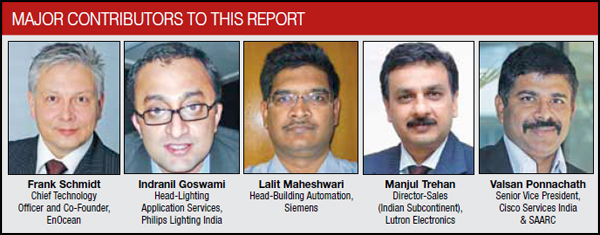1. Batteryless, wireless switches to control lighting and shading
2. Batteryless outdoor light sensors, which automatically match lighting to daylight
3. Occupancy sensor, which adjusts temperature and turns lights off when a room is not in use
4. Room temperature sensor for minimal energy consumption
5. Climatic (humidity and CO2) sensors, which monitor indoor air quality
6. Position sensors—e.g., window handle and window contact—that cut out
heating and air-conditioning when windows are open
7. Central control on a touch panel or PC
8. Remote monitoring and control by a mobile phone or on the Internet
Energy-saving LED lighting
Lighting is one of the most attractive and easy ways to save on your electricity bills. It consumes 19 per cent of all electricity in the world. Replacing energy-inefficient lighting with green alternatives has an immediate impact on energy use, CO2 emissions and the environment.

For light sources, Philips is developing solidstate lighting solutions with increased efficiency and lower costs. In controls, it is developing a range of standalone solutions with dimming, occupancy and daylight sensing applicable to small- and medium-sized buildings. For large buildings, Philips is developing fully networked (wired and wireless) solutions that interface with standard building management systems and include advanced daylight harvesting using controllable motorised blinds and shades. It is also working on interface with the building HVAC systems with integrated control strategies that can optimise the overall energy consumption.
Philips’ Quadra LED and Quadra LED2 luminaires offer up to 45 per cent energy savings compared to the traditional, non-LED based office lighting equipment used in India. The company also offers LED-based lighting solutions for retail and hospitality sector.
Lighting control
Lighting automation systems use occupancy-based lighting control, electronic dimming ballast-based lighting control and programmable time scheduling.
A typical lighting control system consists of:
1. A central processor
2. Light and energy management software
3. Built-in timeclock for scheduling light control
4. Dimming modules for dimming electric light
5. Occupancy sensors for switching off light in vacant space
6. Daylight sensors for daylight harvesting
7. Automated shades for controlling daylight
8. Wall stations for manual control
9. IR or RF remote for personal control of light level
The integration of all these components can dim light to the right level for every activity, thus saving energy and extending lamp life. Timer control can turn light on/off and dim light level automatically during non-peak hours to prevent wastage. Sensor control can prevent wastage of lighting energy in vacant space. Daylight sensors can adjust electric light according to incoming daylight level. Automated shades block sun glare and solar heat gain, thus lowering energy consumption of air-conditioners and providing a comfortable environment. Wall stations or remote controls allow personal control of light level according to individual tasks.
Lutron offers total lighting control solutions for green buildings. The costdepends on the project size, number of circuits and complexity of the system. The payback period for a simple system can be as short as one and a half year to two years. For a complicated system, the payback period ranges from three to five years.
Solar-powered air-conditioning
While solar energy run air-conditioners can provide respite from the scorching heat, these also bring along environmental benefits such as reducing greenhouse gas emissions.
As reported in Times of India, all 40 air-conditioners in the Gujarat Pollution Control Board (GPCB)’s new building run on solar energy. This is the first 100 per cent solar building in India wherein electricity generated from sunlight also powers as many as 600 fans and 1000 CFL tubelights besides the ACs. After investing Rs 10 million in the power system, the GPCB claims that the investment made will be recovered in five years. The investment is inclusive of a ten-year operation and maintenance contract for the building. The solar panels set up atop the building over 2000sq.m space generate 80kW energy.
Chillers and hybrids are the two solar AC variants. Solar-powered absorption chillers cool and heat water through condensation and evaporation. Air temperature drops as it passes across a saturated material. The motor and fan are solar energy powered.
The hybrid system combines direct current and photovoltaic technologies. It automatically switches between battery and solar power as needed. In hybrid mode, the system taps sunlight to charge the batteries. When not in hybrid mode, AC power charges the batteries while the system runs on a battery backup. GreenCore Air has designed such a solar-powered model.
Switch worth the effort
For building managers and owners, the challenge today is to design, build and operate buildings in the most efficient, economical and environmentally responsible way. Investing in green building technologies is the answer for this need.
Most green buildings in India cost a premium of 4-5 per cent, but yield ten times as much over the entire life of the building. The typical payback period for projects in India is estimated to be three to seven years, according to the World Green Building Council.






